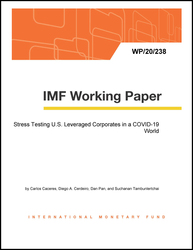
Stress Testing U.S. Leveraged Corporates in a COVID-19 World
Stress Testing U.S. Leveraged Corporates in a COVID-19 World
READ MORE...
Volume/Issue:
Volume 2020
Issue 238
Publication date: November 2020
ISBN: 9781513561134
$20.00
Add to Cart by clicking price of the language and format you'd like to purchase
Available Languages and Formats
| English |
Prices in red indicate formats that are not yet available but are forthcoming.
Topics covered in this book
This title contains information about the following subjects.
Click on a subject if you would like to see other titles with the same subjects.
Finance , Money and Monetary Policy , corporate , firm value , leverage , solvency , liquidity , , WP , cash inflow , equity position metrics , liquidity need , need Lt , net equity position , stress testing , liquidity , leverage ratio , revenue flow , revenue-to-assets ratio , rollover needs , amortization profile , maturing bond debt , maturing debt , Stocks , Corporate sector , Currencies , Loans , Global
Summary
This paper analyzes a group of 755 firms, with aggregate indebtedness of US$6.2 trillion, to assess the solvency risks and liquidity needs facing the U.S. corporate sector based on projections of net income, availability and cost of funding, and debt servicing flows under different stress test scenarios. The paper finds that leveraged corporates account for most of the potential losses arising from the macroeconomic stresses associated with the COVID-19 crisis, with a concentration of these losses in the oil and gas, auto, and capital and durable goods manufacturing sectors. However, potential losses from corporate debt write-downs appear to be a fraction of banks’ capital buffers and, given the size of the leveraged segment and the relatively long duration of that sector’s debt, the near-term liquidity needs of these corporates appear modest. Corporate stresses could, however, amplify the current economic downturn—as firms cut investment spending and reduce employment—potentially giving rise to significant indirect losses for the financial system.
Copyright © 2010 - 2025
Powered by:
AIDC



